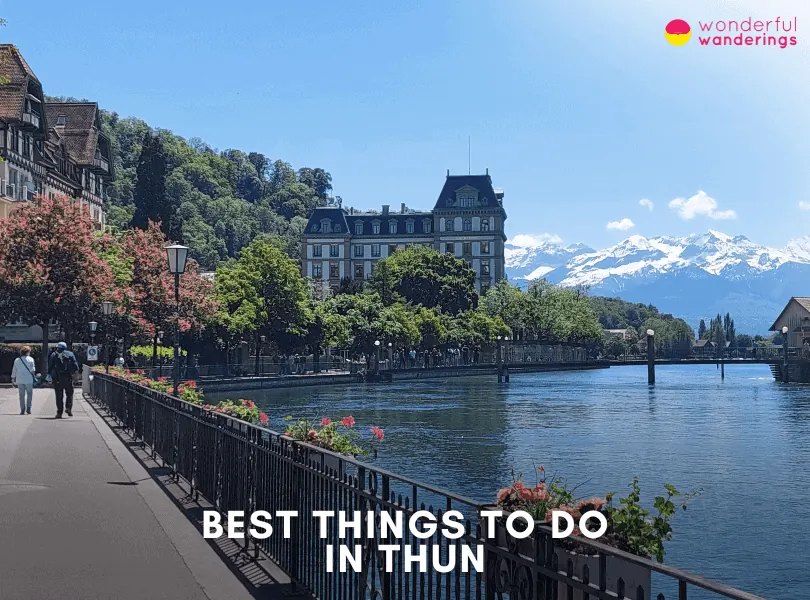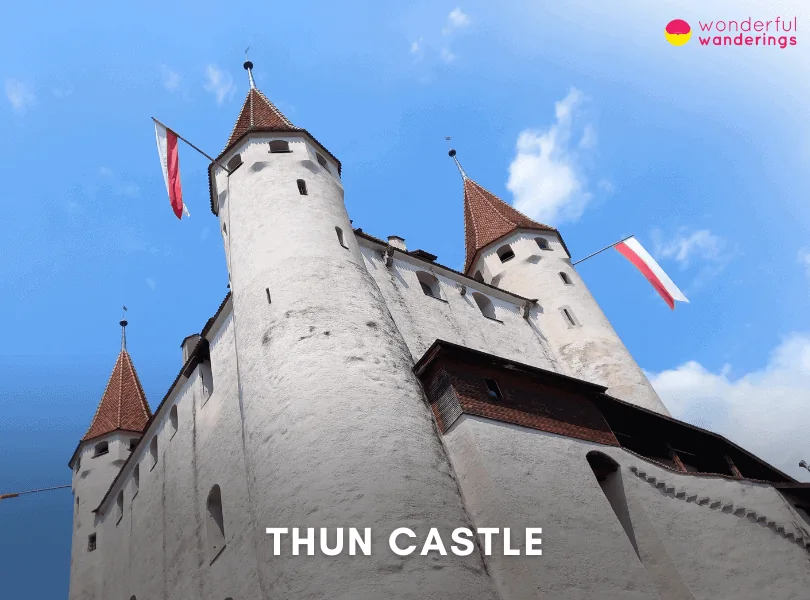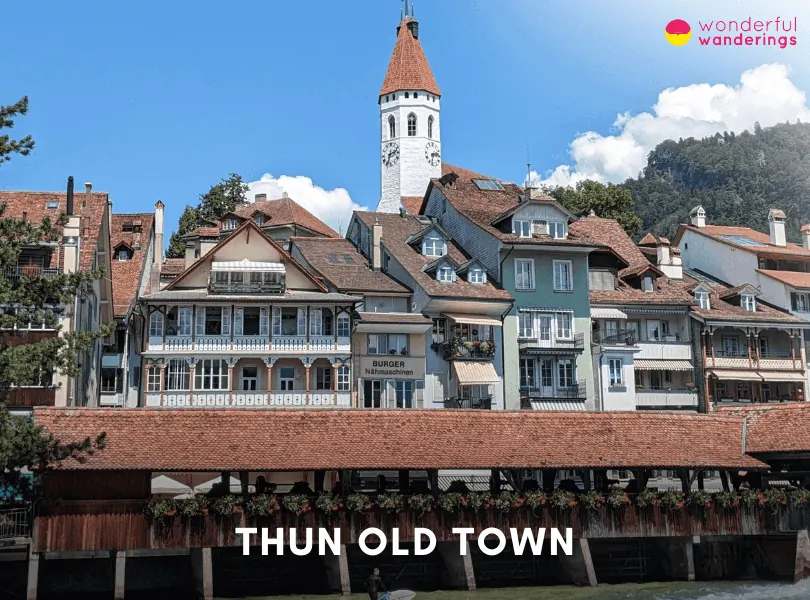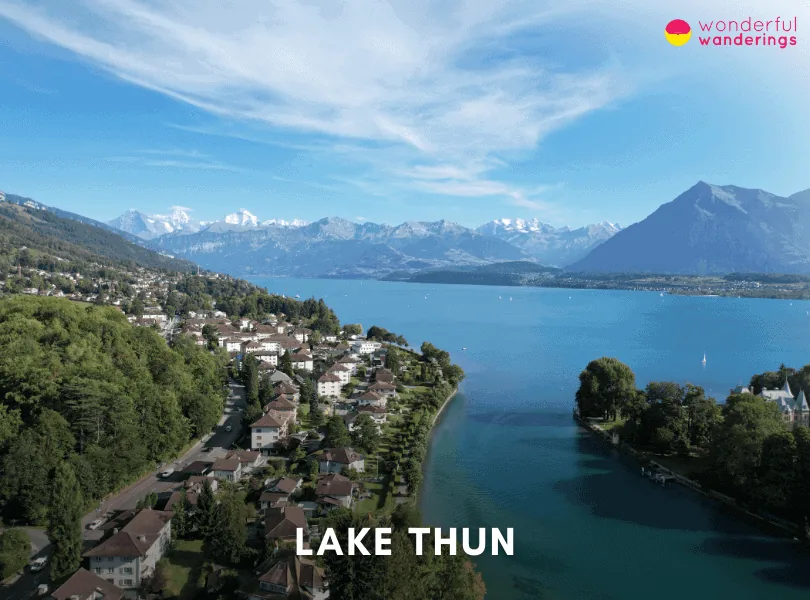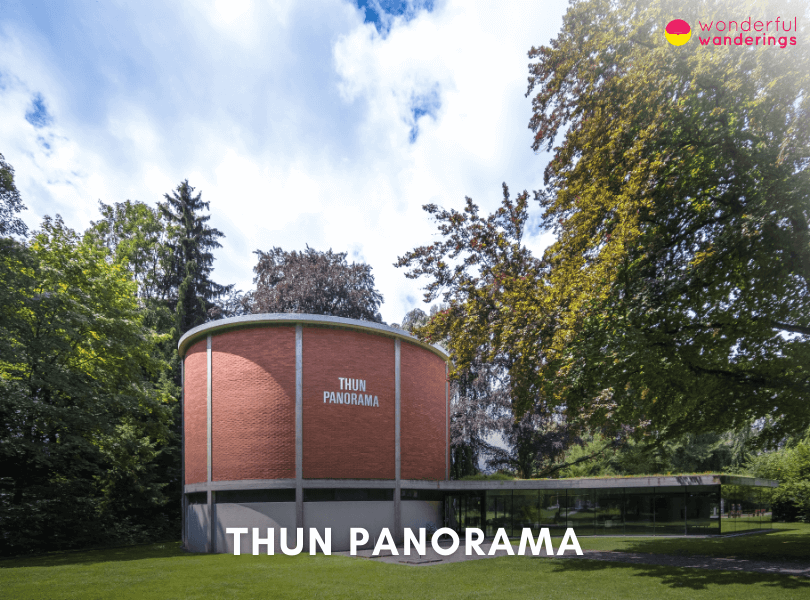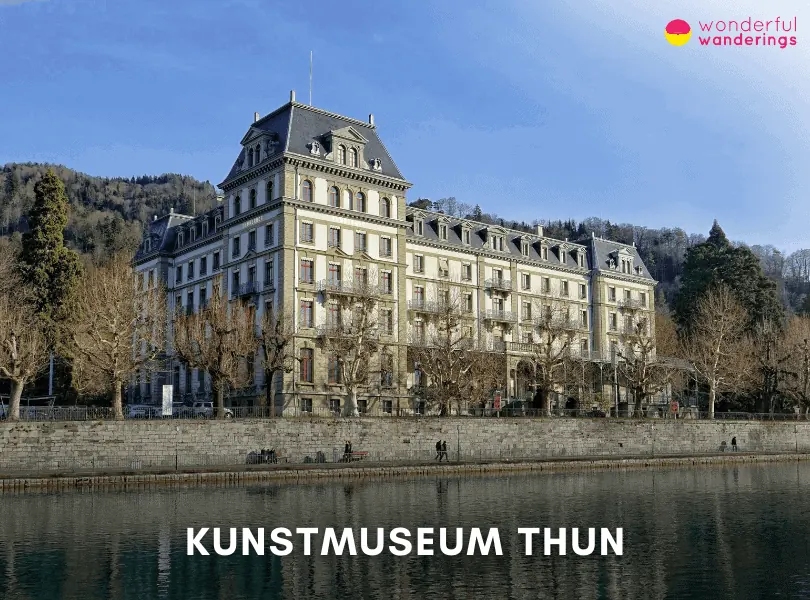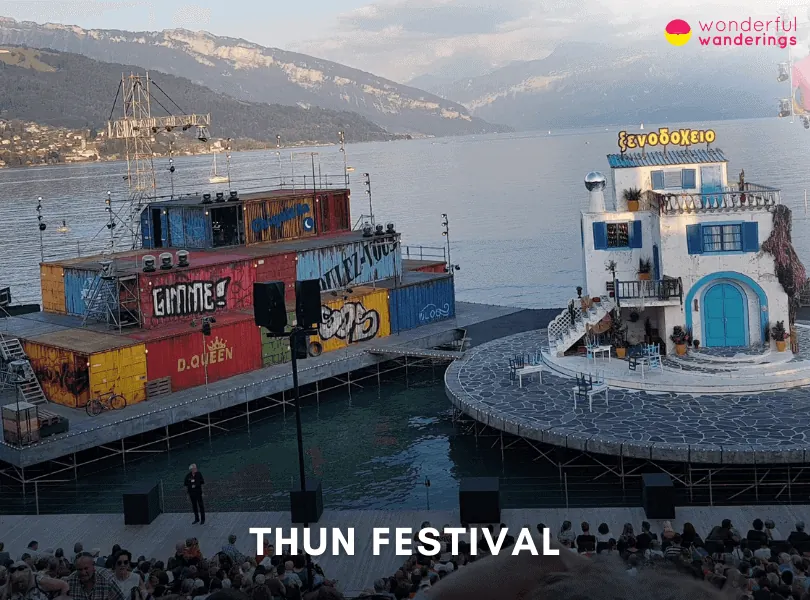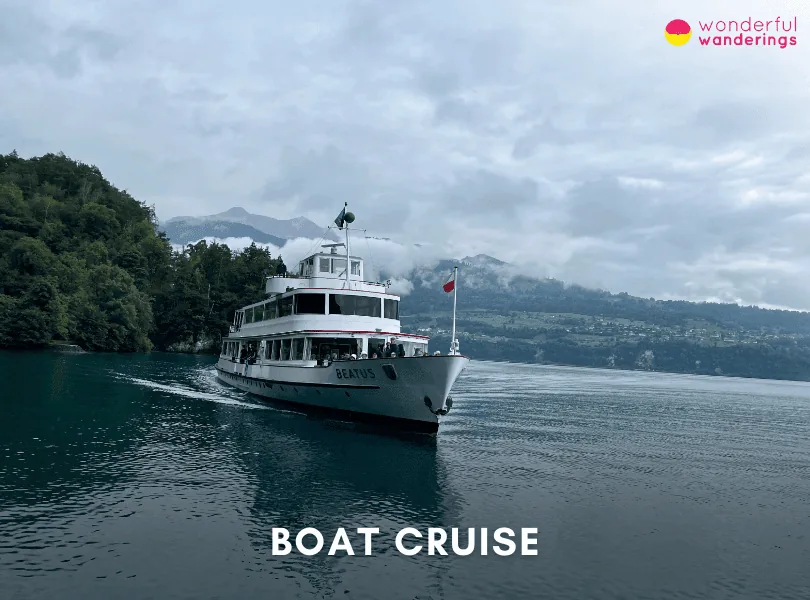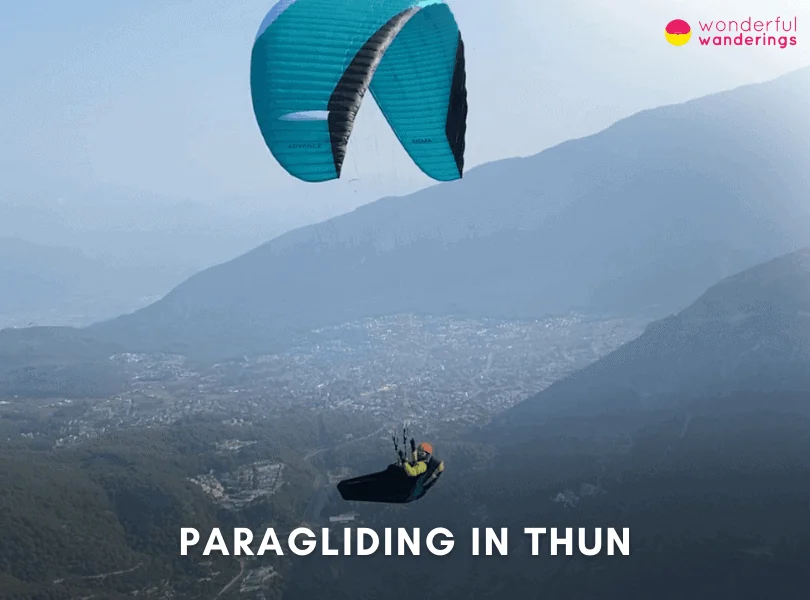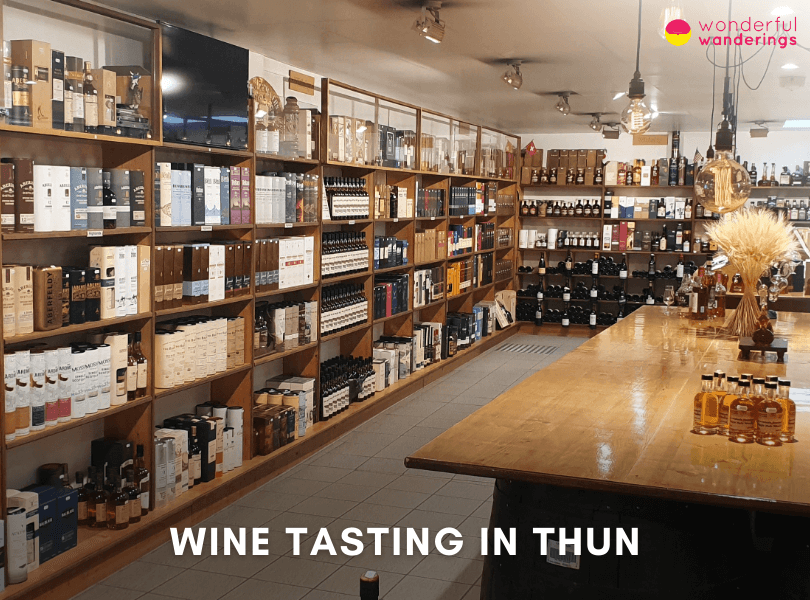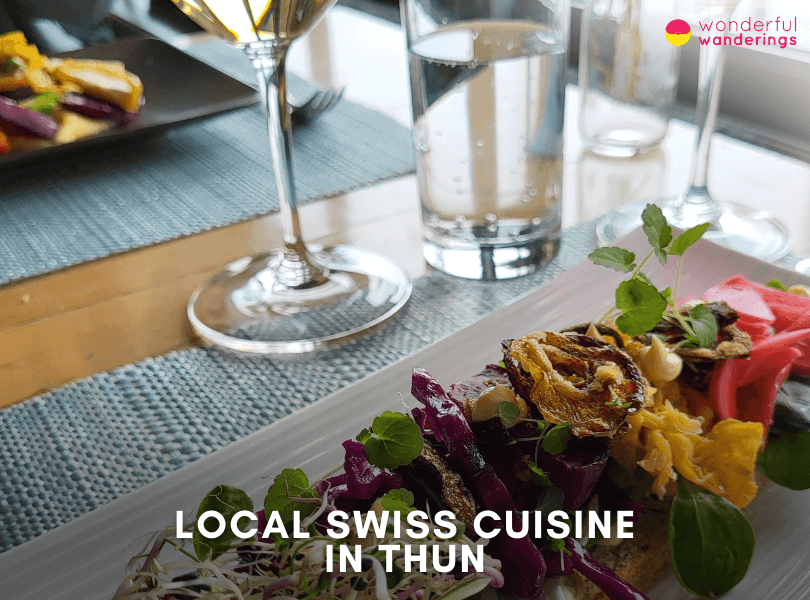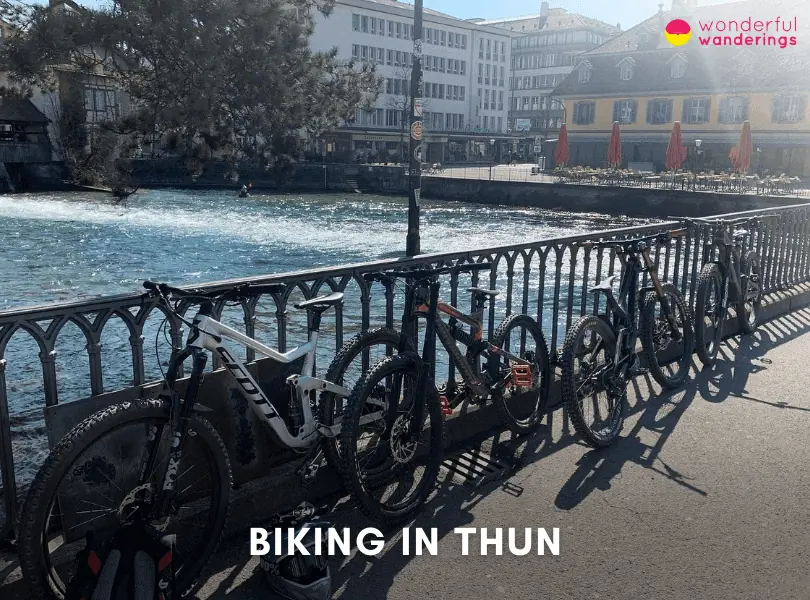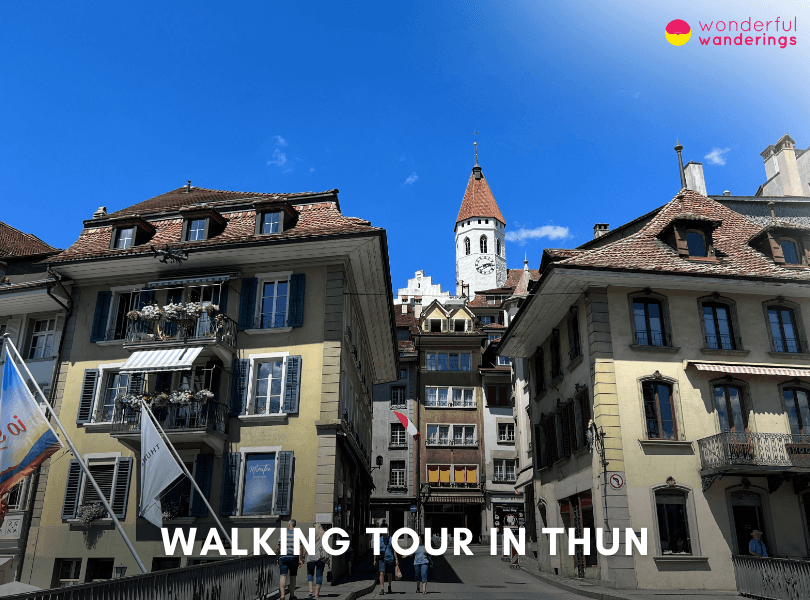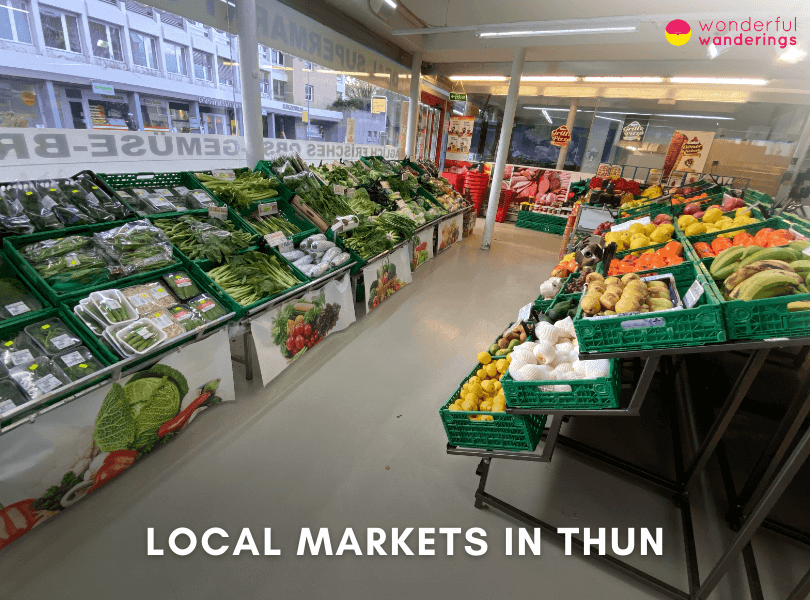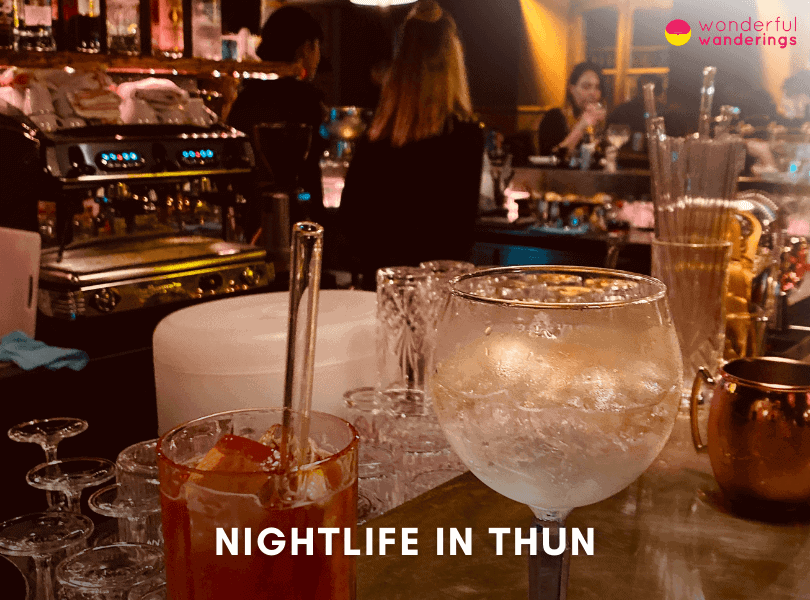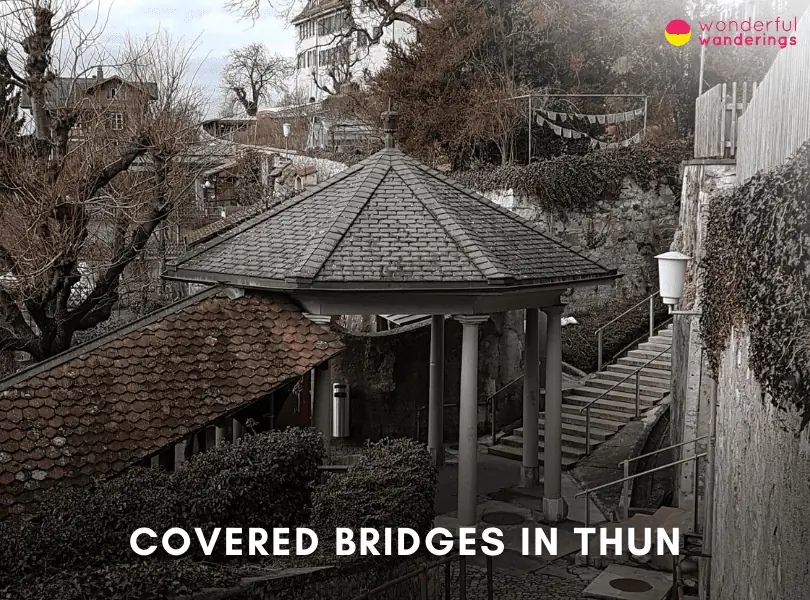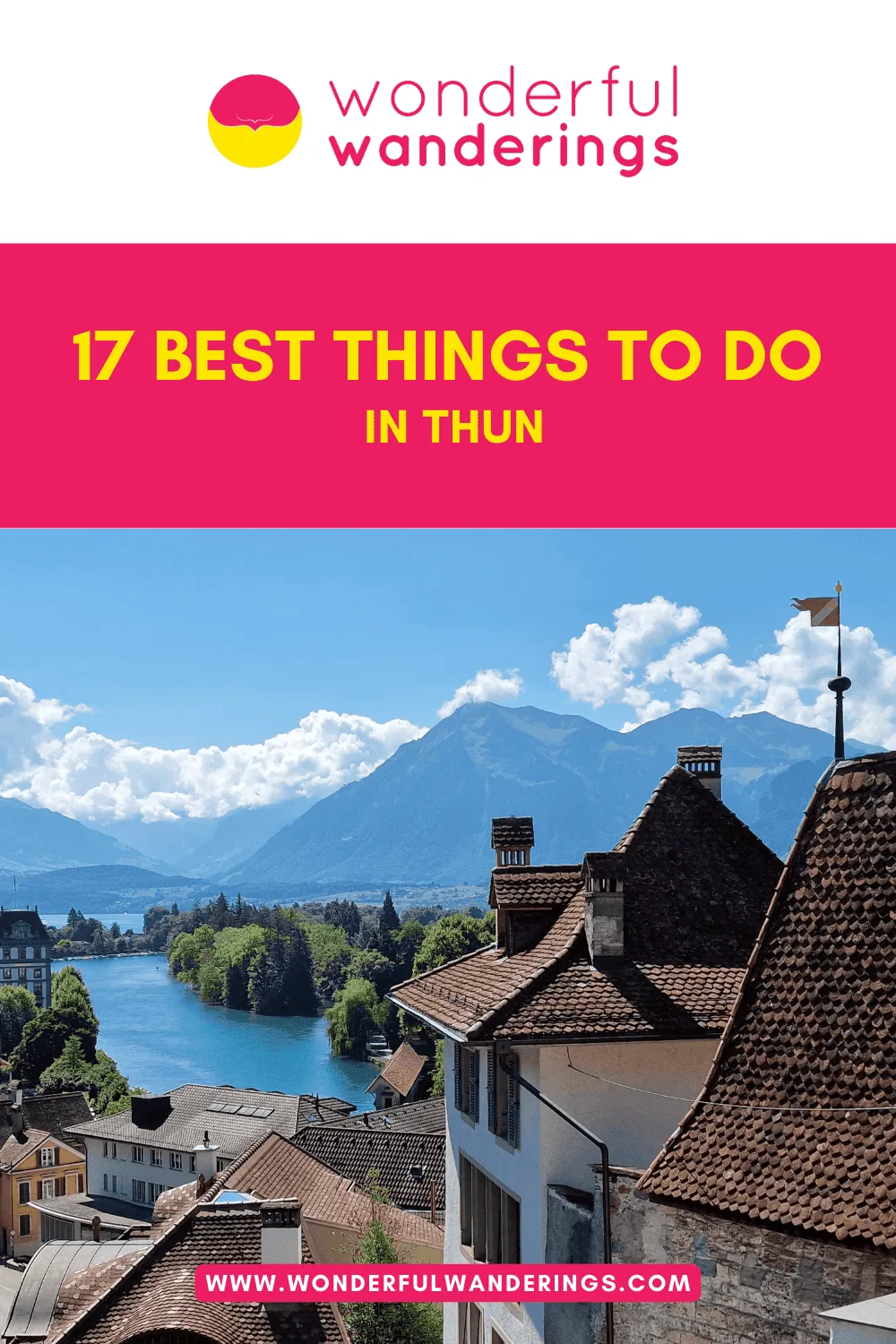Thun is a town and municipality situated in the administrative district of Thun in the canton of Bern, Switzerland. It is where the Aare River flows out of Lake Thun, 30 kilometers (18.64 miles) southeast of Bern. The geographical coordinates of Thun are 46.7580° N, 7.6280° E. The town is surrounded by various municipalities, including Amsoldingen, Heiligenschwendi, Heimberg, Hilterfingen, Homberg, Schwendibach, Spiez, Steffisburg, Thierachern, Uetendorf and Zwieselberg. Thun is the capital of the Thun District in the canton of Bern. The town covers a total area of 21.60 square kilometers (8.34 square miles). As of the latest census, the population of Thun is 43,665. The population is diverse, with Swiss citizens and residents from Germany, France, Italy, Portugal and other European and non-European countries.
Thun has a rich history dating back to the Neolithic age, around the mid-3rd millennium BC, with archaeological evidence of early settlements along the lake shore and the Aare River. The town’s name, believed to have originated from the Celtic term “dunum”, meaning “fortified city”, reflects its history of fortification, notably with the construction of Thun Castle in the 12th century by Duke Berthold V of Zähringen. The castle, now a museum, was inherited by the House of Kyburg in 1218, who built the upper levels. Thun received town rights in 1264 and was bought by the canton of Bern in 1384. It served as the capital of the Canton of Oberland of the Helvetic Republic from 1798 to 1803 and was connected to the Swiss railway network in 1859. The town’s history is marked by physical development, political changes and legends, including links to the ancient Roman Capizucchi family and Saint Vigilus.
Thun plays a significant role in the country’s economy and culture. It is a hub for tourism and machine and precision instrument engineering and is home to the largest garrison in the country. Other significant industries include the food industry, armaments and publishing. Thun is in the Central European Time (CET) zone, which is UTC+01.00 and observes Central European Summer Time (CEST), which is UTC+02.00, during the summer months.
Listed below are the best things to do in Thun.
- Thun Castle. Thun Castle or Schloss Thun, is a 12th-century castle in Thun. Built by Duke Berthold V of Zähringen, it later passed to the House of Kyburg. The castle, a Swiss heritage site, houses a museum across its five floors, showcasing regional history and various exhibitions. The castle’s knights’ hall, a symbol of Zähringen power, is a key feature. Visitors can explore the museum, attend events in the knights’ hall and enjoy views from the towers. The castle caters to all ages, with its historical museum and interactive elements.
- Old Town. Thun Old Town or “Vieille Ville de Thoune”, is a medieval town in Switzerland, 30 kilometers (19 miles) southeast of Bern. It is situated where the Aare River exits Lake Thun. The town features wooden bridges, locks and a castle. The Obere Hauptgasse, with its raised pavements, leads to the Rathausplatz or Mühleplatz, forming the historical center. The townhouses shops, restaurants and bars on two levels. The Mühleplatz, known as the “Mühli”, is a popular relaxation spot by the Aare River. Thun Castle, Lake Thun and Schadaupark & Schloss Schadau are among the attractions. The town caters to all ages, making it suitable for families, couples and solo travelers.
- Lake Thun. Lake Thun or Thunersee, is an Alpine lake in Switzerland’s Bernese Oberland region, covering 48.3 square kilometers (18.65 square miles). Located in the Canton of Berne, it is the largest lake within a single canton. The lake was formed after the last glacial period and was once combined with Lake Brienz as Wendelsee. Fed by water from Lake Brienz and various Oberland streams, Lake Thun is surrounded by mountain scenery, villages and cities like Thun and Interlaken. Activities around the lake include cruising, visiting museums, cycling, paddle boarding and kayaking. The lake is home to several bathing sites and five castles.
- Thun Panorama. The Thun Panorama, known as the Wocher Panorama, is a 360-degree painting by Marquard Wocher from 1814, housed in Schadau Park, Thun. As the world’s oldest surviving panorama, it offers a detailed view of Thun’s early 19th-century life. The panorama, suitable for all ages, is an educational attraction that provides insights into the history and culture of the period.
- Kunstmuseum Thun. Kunstmuseum Thun, situated in the former Grand Hotel Thunerhof, is a hub for contemporary art. The museum, located in the heart of Thun, hosts four to five exhibitions annually, showcasing Swiss and international art. It organizes an annual collection exhibition, presenting a part of its rich pool of artworks from a specific perspective. The museum’s project room, “Enter”, provides a platform for innovative art and current research projects. Art education is a key component of the museum, offering programs that help decode the language of art. The museum caters to art enthusiasts, families and individuals of all ages.
- Thun Festival. Thun Festival refers to cultural events in Thun, including the Lake Thun Festival and Fulehung Festival. The Lake Thun Festival has been an annual summer event since 2003, presenting international musicals and in-house productions against the backdrop of the Eiger, Mönch and Jungfrau mountains, attracting 70,000 visitors annually. It is considered one of Europe’s top 10 open-air musical events. The Fulehung festival is a folk celebration held on the last Monday in September, remembering Fulehung, a court jester from the Burgundian Wars in 1476.
- Boat Cruise. The BLS Lake Thun Cruise in Switzerland offers a two-hour journey from Thun to Interlaken. The cruise, operated by the BLS Lake Thun Navigation Company, provides views of the Eiger, Mönch and Jungfrau mountains. The trip is suitable for all ages and allows visitors to explore Lake Thun, visit castles and enjoy fine cuisine. The cruise offers opportunities for hiking to the Niederhorn and visiting the St. Beatus Caves Sundlauenen. The boat trip is a popular choice for families, couples, solo travelers and groups.
1. Thun Castle
Thun Castle, known as Schloss Thun in German, is a historic castle in the city of Thun, in the Swiss canton of Bern at Schloss Thun, Schlossberg 1, 3600 Thun. It was built in the 12th century. The castle was constructed by Duke Berthold V of Zähringen as a monument to Zähringen power, although the family never lived in the castle, preferring Burgdorf Castle. The House of Kyburg, who added the upper levels above the Zähringen castle, later inherited the castle. Thun Castle houses a museum and is recognized as a Swiss heritage site of national significance. The castle’s five floors feature a historical museum highlighting the region’s history and temporary exhibitions on cultural, historical and current issues. Thun Castle is known for its historical significance and architectural grandeur. It has been preserved well over the centuries. The castle’s knights’ hall, constructed as the centerpiece of a monument to Zähringen power, is a notable feature. Visitors to Thun Castle can explore the historical museum, which showcases the region’s history and hosts temporary exhibitions. Visitors can attend concerts and other public events in the knight’s hall and enjoy the views from the castle’s corner towers.
Thun Castle is accessible on foot from the railway station and the landing stage in 15 minutes. Visitors can stroll through the old town and up the castle stairs or the stairs from the town hall square. Public parking is available at City Ost Schlossberg, City Nord/Grabengut and City West. The admission cost for Thun Castle is €9.30 ($10.50, £7.90) for adults, €7.40 ($8.40, £6.30) for senior citizens, special needs, student/trainees €2.80 ($3.15, £2.35) for children aged six to 16 and €18.60 ($21.00, £15.80) for Family card, two adults plus two children. Thun Castle is suitable for various audiences, including groups, adults and children of all ages. The historical museum and interactive elements cater to a wide range of interests, making it an enjoyable experience for everyone.
2. Thun Old Town
Thun Old Town, known as “Vieille Ville de Thoune”, is located in Thun, a town in the canton of Bern, Switzerland. It is situated where the Aare flows out of Lake Thun (Thunersee), 30 kilometers (19 miles) southeast of Bern. It is a charming medieval town that enchants visitors with its wooden bridges, locks and a castle that dominates the landscape. The town is distinguished by its raised pavements in the Obere Hauptgasse, leading to the Rathausplatz or Mühleplatz, which forms Thun’s historical center. It is home to family-run shops, restaurants and bars on two levels, offering a unique shopping and dining experience. The Mühleplatz, affectionately referred to as the “Mühli” by the townsfolk, is a great place to relax on the banks of the River Aare. Visitors to Thun Old Town can stroll along the raised pavements, visit family-run shops, dine in local restaurants and relax at the Mühleplatz. Visitors can visit Thun Castle, explore the Old Town, take a boat ride on Lake Thun and relax at Schadaupark & Schloss Schadau.
Thun Old Town is accessible by train. It is a quick walk to the Old Town from the train station. There is no admission cost to enter Thun Old Town. Certain attractions within the town, such as the Thun Castle, require an entrance fee. Thun Old Town offers activities for all ages, making it an ideal destination for families, couples and solo travelers.
3. Lake Thun
Lake Thun, known in German as Thunersee, is an Alpine lake in the Bernese Oberland region of Switzerland. The lake is in the Canton of Berne, Switzerland, with the city of Thun on its northern shore. It was named after the city of Thun. It is the largest within a single canton in Switzerland, covering 48.3 square kilometers (18.65 square miles). It was formed after the last glacial period and was once combined with Lake Brienz to form Wendelsee or “Lake Wendel”. After the 10th century, the two lakes split. Lake Thun’s catchment area spans 2,500 square kilometers (965.26 square miles), which can lead to local flooding after heavy rainfalls due to the limited capacity of the Aare River, which drains the lake. The water from Lake Brienz to the southeast, 6 meters (6.56 yards) higher than Lake Thun and various streams in the Oberland, including the Kander, fed the lake. Lake Thun is amidst mountain scenery, surrounded by villages and the cities of Thun and Interlaken. It is the largest lake in the Bernese Oberland and offers views of the Eiger, Monch and Jungfrau in the distance. The castles and vineyards that dot its shores enhance the deep blue color of the lake. Visitors to Lake Thun can engage in a variety of activities. Visitors can cruise on the lake, visit one of the museums in Thun, rent a bicycle for some exercise or try paddle boarding or kayaking on the lake. The lake is home to several bathing sites. Visitors can explore the five castles dotted around Lake Thun.
Visitors can use the Panorama Card Thunersee, which provides access to buses, museums and other points of interest in Thun, to get to Lake Thun. Public parking is available in the area for those visiting by car. Lake Thun cruise tickets are available on the spot at ticket offices in Thun, Interlaken West Interlaken Ost, Brienz and Spiez or booked online ahead of time. Lake Thun has no admission fee for simply visiting or viewing the lake. Activities such as boat cruises have associated costs. A boat ride between Interlaken West and Thun in 2nd class costs €47.50($53.50, £40.50) without a rail pass. Day passes for unlimited cruises on the lake are available. Lake Thun offers activities for a wide range of audiences, best for enthusiasts interested in exploring the castles, an adventure lover keen on water sports or someone simply looking to enjoy the lake and its surroundings.
4. Thun Panorama
Thun Panorama, known as the Wocher Panorama, is a unique cultural attraction in Thun. The circular painting, created by Marquard Wocher in 1814, is the oldest surviving panorama in the world. It provides a 360-degree view of Thun and its surroundings, capturing the everyday life of the early 19th century in remarkable detail. The panorama is in the Schadau Park, on the southern edge of Lake Thun. Visitors can appreciate the intricate details of the painting and learn about the history and culture of the period through the accompanying exhibition. The panorama is a testament to the artistic and cultural heritage of Thun, offering a unique perspective on the town’s past.
Thun Panorama is straightforward. Thun is well-connected by public transport, with regular train services from major Swiss cities. The panorama is a short bus ride or a pleasant walk along the lake from Thun train station. The general admission fee is €9.30, $10.40, £7.80), while children under 16 and holders of the Swiss Museum Pass can enter for free. The panorama is suitable for all ages, offering an engaging and educational experience for children and adults.
5. Kunstmuseum Thun
Kunstmuseum Thun, known as Thun Art Museum, is an intimate museum in the former Grand Hotel Thunerhof, a luxury hotel built in the 1870s. It is located at Thunerhof, Hofstettenstrasse 14, CH-3602 Thun, in the center of the town, directly on the river Aare. The museum primarily focuses on contemporary art, showcasing four to five alternating exhibitions every year. These exhibitions feature Swiss and international art, engaging audiences in the current art discourse and establishing the museum’s reputation beyond the region. The museum organizes an annual collection exhibition, presenting a part of its rich pool of artworks from a specific perspective, in addition to thematically and monographically focused exhibitions. Art education is an integral part of the museum, offering a broad portfolio of programs that help decode the language of art and encourage personal interpretations. The museum features a project room called “Enter”, which serves as a platform for innovative art, offering scope for artistic experimentation and insight into current research projects. Visitors can explore the museum’s contemporary art exhibitions, engage in art education programs and participate in various events and activities organized by the museum. They can visit the “Enter” project room to experience innovative art and artistic experiments.
Visitors going for the train to reach Kunstmuseum Thun should travel to Thun SBB station, then walk for 7 minutes or take bus NFB 21 (direction Beatenbucht) to Thunerhof stop. Visitors opting for a car should exit Thun Nord (direction Oberhofen, Interlaken) and find paid parking opposite the building. The admission fee for adults is €8.40 ($9.50, £7.10) and for students, AHV and IV is €7.45 ($8.45, £6.30). Children up to 16 of age, school classes and teachers can enter for free. Groups of 10 or more adults receive a 10% discount. Kunstmuseum Thun is for art enthusiasts, families and individuals of all ages interested in contemporary art and art education. The museum’s art education programs cater to a wide range of age groups, making it an engaging experience for young and old visitors.
6. Thun Festival
Thun Festival refers to several cultural events held in Thun. The most prominent is the Lake Thun Festival, an annual summer event presenting international musicals and in-house productions since 2003. The festival, staged against the backdrop of the UNESCO-protected mountain landscape of the Eiger, Mönch and Jungfrau, attracts 70,000 visitors to Lake Thun annually. It is considered one of Europe’s top 10 open-air musical events, featuring international classics like Evita and West Side Story and award-winning in-house productions. Another event is the Fulehung festival, a folk celebration held on the last Monday in September, where the people of Thun remember a historical figure known as Fulehung, a court jester from the time of the Burgundian Wars in 1476. Thun Festival takes place in Thun, located at the north-western end of Lake Thun, in the Bernese Oberland region of Switzerland. Visitors to the Thun Festival can enjoy a variety of activities. At the Lake Thun Festival, they can watch world-class musical performances on a stage set against a breathtaking mountain panorama. At the Fulehung festival, visitors can participate in the city’s folk celebration, which includes a parade and street dance.
Thun is well connected to Switzerland’s rail network. It is accessible by train from Bern in 20 minutes or Zurich in 90 minutes. The city is served by Bus #21, which connects Thun with Interlaken West. The cost of admission to the Thun Festival varies depending on the event. Tickets for the Lake Thun Festival are available through various systems, such as Ticketcorner, Starticket and Kulturticket. The Thun Festival caters to adults and children. The Lake Thun Festival, with its musical performances, is a treat for music and theater lovers. The Fulehung festival, with its folk celebration and street dance, offers fun for the whole family.
7. Boat Cruise
A Boat Cruise in Thun is a captivating journey on the clear, blue waters of Lake Thun, the largest lake in the Bernese Oberland region. It is known as the BLS cruises on Lake Thun, named after the BLS Lake Thun Navigation Company that operates the cruises. The cruise offers an unhurried two-hour trip from Thun to Interlaken, allowing visitors to indulge in fine cuisine while admiring the castles on the banks and the mountains beyond. The deep blue Lake Thun lies between Thun and Interlaken, surrounded by imposing mountain scenery. The cruise provides a panorama of the Eiger, Mönch and Jungfrau. The boat trip is suitable for discovering around Lake Thun. Visitors can enjoy the passing landscapes, indulge in fine cuisine and admire the historic castles and the unique panorama of the Eiger, Mönch and Jungfrau during the boat cruise. Visitors can visit the castles around Lake Thun, hike to the Niederhorn, see St. Beatus Caves Sundlauenen and enjoy evening cruises on Lake Thun.
Visitors can travel by train and bus to every stop on Lake Thun to get to the Boat Cruise in Thun, free of charge with the Berner Oberland Pass. The departure point for the boat trip on Lake Thun is at Schiffstation Thun, Seestrasse 9, 3600 Thun. The admission cost for the Boat Cruise in Thun, is €47.50 ($53.50, £40.50) for a single boat ride between Interlaken West and Thun in 2nd class without a rail pass. Visitors can travel free of charge by train and bus to every stop on Lake Thun with the Berner Oberland Pass. The Boat Cruise in Thun, is best for families with kids, couples, solo travelers and groups. The boat cruise offers an enjoyable experience for people of all ages.
8. Schadau Park
Schadau Park, known as Park Schadau, is a captivating public park in Thun. This park, situated on the southern bank of Lake Thun, is a haven of natural beauty and historical significance. It is known for its meticulously maintained gardens, the grand Schadau Castle and the Swiss Gastronomy Museum. Visitors to Schadau Park can enjoy strolls along the lake, picnics in the lush green spaces and exploration of the castle and museum. The park offers breathtaking views of the lake and the surrounding mountains, making it a photographer’s paradise. The park’s location, near the city of Thun, makes it accessible for locals and tourists.
Schadau Park is straightforward. The park is in Thun, which is well-connected by public transportation. Visitors can reach Thun by train from various Swiss cities and from the Thun railway station, the park is a short walk away. There are public parking spaces available near the park for those driving. Schadau Park is open to everyone and there is no admission fee as a public park. The park is for all visitors, including families with children, couples, solo travelers and groups. It offers a variety of activities that cater to different interests, from leisurely activities like picnicking and walking to more educational pursuits like visiting the museum nearby.
9. Paragliding in Thun
Paragliding in Thun is an exhilarating activity that offers a unique perspective of the scenic Swiss landscape. Thun, a city located in the canton of Bern, is a popular destination for paragliding due to its weather conditions and views of the Swiss Alps and Lake Thun. Paragliding in Thun is facilitated by several companies, including Advance Thun SA, a manufacturer of paragliders and Swissgliders, a paragliding school based in Thun. The activity allows visitors to experience the thrill of flight and the beauty of the Swiss landscape from a bird’s eye view. During a paragliding session, visitors can soar high above the city, the lake and the surrounding mountains, experiencing the landscape in a way that is not possible from the ground.
Visitors can use various modes of transportation to get to Thun for paragliding. The city is well-connected by road and rail networks, accessible from other parts of Switzerland and neighboring countries. Once in Thun, visitors can use local buses or taxis to reach the paragliding sites. The cost of paragliding in Thun varies depending on the service provider and the type of flight. A tandem paragliding flight with Paragliding Interlaken costs €213 ($240, £180). Paragliding in Thun is suitable for a wide range of people, including adventure seekers, nature lovers and those who enjoy outdoor activities. It is not for very young children or those with certain health conditions.
Paragliding in Thun is facilitated by several companies, each with its own specific location. One of the leading manufacturers of paragliders, ADVANCE Thun AG, is located at Uttigenstrasse 87, 3600 Thun. Another company, Swissgliders, a paragliding school, is at Von May-Strasse 33, 3604 Thun. The addresses are for the companies’ offices and the actual paragliding launch sites vary depending on weather conditions and other factors. It is advisable to contact the companies directly for the most accurate and up-to-date information.
10. Wine Tasting in Thun
Wine tasting in Thun is an enriching experience that allows visitors to explore the rich viticulture of the region. Thun is known for its high-quality wines due to its unique climate and the variety of vines grown in the area. Spiezer Alpine Weinkultur is one of the most notable vineyards in Thun, recognized for its high-lying vineyards and the production of sophisticated, elegant and fruity wines. The vineyard is at Schlosstrasse 8, CH–3700 Spiez, a nearby city.
The opportunity to taste wines that reflect the pre-alpine landscape and are known for their quality and authenticity makes wine tasting in Thun special. Visitors can participate in guided tours and tastings or visitors can choose to stroll through the vineyard independently. The city of Thun offers a unique blend of historical charm and natural beauty, with its historic buildings, lake views and the backdrop of the Bernese Alps.
Various modes of transportation are available to reach Thun for wine tasting. The city is well-connected by train, accessible from major Swiss cities like Zurich, Lausanne, Geneva, Interlaken and Montreux. Visitors can reach the vineyards by local transport or on foot, depending on the distance, once in Thun. The cost of entering the vineyards for wine tasting can vary. It is recommended to check with the individual vineyard for the most accurate information. Spiezer Alpine Weinkultur offers wine sales and tastings at specific times. Wine tasting in Thun is for adults, particularly those interested in viticulture and the wine-making process. It provides an opportunity to learn about the unique characteristics of Swiss wines and the factors that contribute to their quality and flavor.
11. Local Swiss Cuisine in Thun
Local Swiss Cuisine in Thun is a delightful culinary experience showcasing the rich gastronomic traditions of the Swiss region. Thun is known for its diverse food scene that ranges from traditional Swiss dishes to innovative culinary creations. Restaurants, cafes and specialty food shops mark the city’s landscape, each offering a unique taste of Swiss cuisine. Visitors can indulge in local delicacies such as cheese fondue, rosti and Zurchergeschnetzeltes. The city hosts a food trail, an enjoyable scavenger hunt that introduces participants to Thun’s culinary delights. Thun’s food scene includes specialty food shops like Simplyfine, which curates fine Swiss foods and Naturkostbar, known for its Swiss-quality vegan chocolates.
Thun is straightforward. Direct flights are available from London to Zurich and from Zurich, it is an hour and a half to Thun by train. Visitors can take the Eurostar to Paris, then catch the TGV to Bern and connect to Thun. It is easy to get around Thun upon arrival, with frequent trains, buses and boats linking the city’s various attractions. There is no admission fee for accessing the city as it is open to all. Individual attractions, restaurants and activities have their own costs. The city’s culinary offerings cater to a wide audience, from food enthusiasts to families and even those with a penchant for adventure, making it an ideal destination for all visitors.
12. Biking in Thun
Biking in Thun is a popular activity that allows visitors to explore the scenic landscapes of this region in the Bernese Oberland. Thun offers a variety of biking routes that cater to different skill levels, from easy rides to challenging trails. One of the most notable routes is the Lake Thun Loop, a panoramic circular trail that offers views of the deep blue waters of the lake and the surrounding mountains. This route passes through idyllic villages, green meadows and historic buildings, providing a unique way to experience the local culture and natural beauty of the area. Biking in Thun is not just limited to leisurely rides; it hosts competitive events like the IRONMAN Switzerland, which moved to Thun after 23 years in Zurich.
Thun is easily accessible by various modes of transportation. Visitors traveling from within Switzerland can take a train to Thun Station. The nearest major airport is Bern Airport for international travelers, from which visitors can take a train or a bus to Thun. Visitors can rent a bike from various rental services available in the town, once in Thun. The Donkey Republic bike-sharing service allows renting a bike at any time of the day using a smartphone app. Other bike rental services are available at Thun Station and throughout the town. The cost of bike rental varies depending on the type of bike and the duration of the rental. Biking in Thun is suitable for a wide range of people, from families with children to experienced cyclists. The routes available caters to different skill levels, making it an enjoyable activity for everyone.
13. Walking Tour in Thun
A Walking Tour in Thun is an immersive exploration of Thun. The guided or self-guided tour takes visitors through the city’s historic Old Town, over the Schlossberg mountain and along the banks of the River Aare. Thun is known for its unique raised pavements, a distinctive feature in Europe and its medieval castle that overlooks the city from the Schlossberg. The city is home to the city church, Stadtkirche, on the Schlossberg, offering impressive views of the Alps. Visitors can enjoy the city’s rich history and explore traditional businesses, trendy bars and winding passages lined with historic buildings. The city hosts a market twice a week in Bälliz, Thun’s shopping island, adding to its appeal. The tour includes vantage points of Lake Thun and the Bernese Alps, offering a touch of nature during the trip. Visitors opting for Thun for the walking tour are accessible through various means of transportation. The city is well-connected by train, with efficient connections from major Swiss airports and towns.
Thun is reachable by Switzerland’s motorway for those who prefer road travel, A1/A6 from Basel, the A3/A1 and A6 from Zurich or the A1/A6 from Geneva. The historic center is small enough to explore on foot once in Thun. Public transport is available for those located on the outskirts of Thun or in one of the nearby villages. The walking tour is free, with guides working on a tip basis, making it accessible for anyone, regardless of budget. The walking tour is best for everyone, including history enthusiasts, nature lovers and those interested in architecture and culture.
14. Fishing in Thun
Fishing in Thun is an outdoor activity that happens in the scenic town of Thun, located near Lake Thun and the Bernese Oberland region. Thun is known for its lake, mountain views and historic Thun Castle, which dates back to the 12th century. Fishing in Thun offers visitors the opportunity to enjoy the natural beauty of the Swiss Alps while engaging in a relaxing and rewarding pastime. The town’s proximity to Lake Thun provides an ideal setting for fishing enthusiasts to cast their lines and try their luck at catching various fish species.
Visitors can use public transportation, such as trains and buses, which connect Thun to major Swiss cities, to get to Thun. Thun Castle is a 15-minute walk from the train station. Parking lots near the castle on Burgstrasse, which charge per hour during the morning, are available for Visitors who opt to drive. Fishing in Thun is suitable for various audiences, including families, couples and solo travelers who enjoy outdoor activities and appreciate the natural beauty of the Swiss Alps.
Fishing in Thun is primarily done in Lake Thun. There is no specific address for fishing in the lake. The activity is accessible from various points along the lake’s shore. The Thun-Thunersee Tourismus Welcome Centre, located in the Thun train station, is a good starting point for information about fishing and other activities in the area. Fishing in Switzerland requires a license and regulations about fishing seasons, allowed equipment and catch limits may apply. It is recommended to check with local authorities or fishing supply stores for the most accurate and up-to-date information.
15. Local Markets in Thun
Local markets in Thun, known as Thun’s farmers markets, are a significant part of the city’s cultural and social fabric. These markets are primarily located along the pedestrian-only shopping street Bälliz and on the island in the Aare. They offer a variety of goods, from fresh produce and handmade pasta to locally pressed olive oil. The markets are not limited to food items. 80% consists of non-food items such as clothes, knitted goods and trinkets. The markets provide a platform for local producers to sell their goods directly to consumers, fostering a sense of community. Visitors can explore the markets, interact with local vendors and purchase unique, locally-made products.
Local markets in Thun are straightforward. Thun is well connected to Switzerland’s rail network and it can be reached by train from Bern in 20 minutes or Zurich in 90 minutes. The city is very walkable and the markets are within walking distance from the train station. There is no admission cost to enter the markets, making them accessible to everyone. The markets are for all types of people, including families, tourists and locals. They offer a unique experience for children to learn about local produce and goods, while adults can enjoy shopping for unique items and fresh, locally sourced food.
16. Nightlife in Thun
Nightlife in Thun is a blend of local bars, pubs and clubs that offer a variety of experiences for visitors. The nightlife in Thun is a unique blend of Swiss charm and modern entertainment. Visitors can enjoy activities, from savoring local and international drinks at bars like Loft 27 and Schmiedstube Bar to dancing the night away at clubs ARX Club and Route 66. Thun’s nightlife includes unique experiences, like the Eden Beach Lounge Bar, which offers spectacular views of the Alps and Lake Thunersee.
Thun is well-connected by public transportation, including buses and trains. The STI Bus AG Thun provides regular services throughout the Thun region, including late-night routes, making it a convenient option for those planning to enjoy the nightlife. The bus network covers 21 regular services, 7 Moonliner routes, 38 communes and 392 stops. The cost of admission to nightlife venues in Thun varies depending on the establishment, with some offering free entry while others may charge a cover fee. The nightlife in Thun caters to adults of all ages. The primary audience tends to be adults over the legal drinking age, as with most nightlife venues.
17. Covered Bridges in Thun
Covered bridges in Thun are a unique architectural feature that adds to the city’s charm. These bridges, often referred to as wooden covered staircases, are a part of the city’s historical fabric, providing a glimpse into the past. One such example is the Kirchtreppe, a 19th-century wooden covered staircase that leads up to Thun Castle. The staircase, adorned with gables, ends at a small pavilion embellished with modern art that depicts Thun’s history. The covered bridges are located in the heart of Thun, a city situated in the administrative district of Thun in the canton of Bern, Switzerland. The bridges provide shelter from the elements. Visitors can walk through these bridges, experiencing a sense of stepping back in time. The bridges offer a unique vantage point for viewing the city’s beautiful old town and the surrounding landscape. The covered bridges, particularly the Kirchtreppe, are a part of the journey to Thun Castle, adding to the experience of exploring the city.
Visitors can use the city’s public transport system to reach the covered bridges in Thun. The bridges are a 15-minute walk from the railway station. Visitors can stroll through the old city, up the castle stairs or the stairs leading from the town hall square. Public parking is available for those driving, offering space for 310 cars and an elevator up to the castle. The closest public car parks are City Nord/Grabengut and City West. The exact address is Thun Castle, Schlossberg 1, CH-3600 Thun. There is no admission cost to walk through the covered bridges. They are open to the public and enjoyed by all visitors, from history enthusiasts to families with children. The bridges offer a unique experience, combining history, architecture and beautiful views, making them a must-visit in Thun.
What are the best museums to visit in Thun?
Listed below are the best museums to visit in Thun.
- The Swiss Army Tank Collection. The Swiss Army Tank Collection is a military museum inside the Thun military base at Kommando Waffenplatz Thun Kaserne, Thun. This unique museum houses an impressive collection of historical tanks and armored vehicles from Switzerland and around the world, spanning from World War I to the present day. Visitors can explore tanks from the Swiss, German, American, British, Russian and other armies. Highlights include rare Swiss tanks like the Panzerjäger G13 and Sturmpanzerwagen 39, as well as iconic German tanks like the Panzer IV and Tiger I. The museum offers an insightful look into the development of tanks and military technology over the past century. Admission is free.
- Thun Castle Museum. Thun Castle Museum is inside the medieval Thun Castle at Schlossberg 1, 3600 Thun. The castle was first built in 1190 AD by Duke Berchtold V of Zähringen and now houses a museum chronicling the history of Thun and the surrounding Bernese Oberland region from the 12th to the 19th centuries. Exhibitions feature weapons, uniforms, coins, pottery, religious artwork and archaeological findings. Visitors can admire the castle’s Knights’ Hall, one of the few intact medieval halls in Switzerland. General admission cost is €9.30 ($10.52, £7.97).
- Thun Panorama. The Thun Panorama is a circular panoramic painting from 1814 that offers breathtaking 360-degree views of Lake Thun, the town of Thun and the Bernese Alps. Created by Swiss artist Marquard Wocher, it is the oldest surviving panoramic painting in the world. It is at Schadaupark, 3600 Thun, this 38-meter-long artwork provides a charming glimpse into life in Thun in the early 19th century. An audio guide is available to provide background on the many intricacies within the painting. General admission cost is €8.37 ($9.47, £7.18).
- Kunstmuseum Thun. The Kunstmuseum Thun is Thun’s modern art museum, housed inside the historic Grand Hotel Thunerhof building along the Aare River at Hofstettenstrasse 14, 3602 Thun. The museum presents 4-5 temporary contemporary art exhibitions annually, showcasing Swiss and international artists. The diverse exhibitions feature painting, sculpture, video, installation and conceptual art by modern artists, as well as up-and-coming talents. Admission starts at €9.30 ($10.52, £7.97)
- Burgerbibliothek Thun. The Burgerbibliothek Thun (Thun Civic Library) contains a museum and archives showcasing the history and development of the city of Thun from the 13th century until today. It is at Hofstettenstrasse 14, 3602 Thun, inside the historic Grand Hotel Thunerhof. The library holds a collection of over 40,000 documents, books, photographs and objects related to Thun’s past. Exhibitions and events are held in the Bibliothekssaal hall. Admission is free.
What are the best things to do in Thun with kids?
Listed below are the best things to do in Thun with kids.
- Discover History at Thun Castle. Thun Castle is a historical landmark that offers a unique learning experience for children. The castle was built by Duke Berchtold V of Zähringen in 1190. It now houses a museum that explores the history of the town and region. The castle features games, concerts and open-air theater, providing entertainment options for families with kids. The castle is at Schlossberg 1, 3600 Thun. The general admission cost at Thun Castle is €9.20 ($10.80, £8.00).
- Unleash Creativity at Thun-Panorama. Thun-Panorama is a unique attraction in Thun that offers a 360-degree view of the city and its surroundings. The panorama is a large circular painting that depicts the city of Thun, Lake Thun and the Bernese Alps in incredible detail. It is a great way for children to learn about art and history while enjoying the views. The Thun-Panorama is at Seestrasse 53, 3600 Thun. General admission fee at Thun-Panorama is €8.28 ($9.72, £7.20).
- Run around at Schadau Park. Schadau Park is a beautiful park at the tip of a peninsula in Thun, offering a refreshing break for children and families. The park features a variety of attractions, including a playground, picnic areas and walking paths. It is a perfect place for children to run around and play, while adults can relax and enjoy the views of Lake Thun and the surrounding mountains. The park is at Seestrasse, 3600 Thun. There is no admission cost to enter the park.
What are the best activities for a business traveler in Thun?
Listed are the best activities for a business traveler in Thun.
- Boat Cruise on Lake Thun. A boat cruise on Lake Thun, departing from BLS Schifffahrt AG at Lachenweg 19, 3604 Thun, provides a unique meeting experience for the business traveler. The cruise sails on the clear, blue waters of Lake Thun, offering a backdrop of the Bernese Oberland mountains. The setting, with the historic castles dotting the banks, creates an ambiance for business discussions. The cruise includes fine dining options, adding a touch of luxury to the meeting experience. The journey from the Beatus Caves to Thun lasts over 1 ½ hours, offering ample time for productive conversations. The cost for a first-class ticket is €98.00 ($110.00, £83.00), while a second-class ticket costs €67.00 ($75.00, £57.00). It is advisable to check the latest rates before planning the trip, as prices vary.
- Attend a Business Event at KKThun. KKThun, situated at Seestrasse 68, 3600 Thun, is a versatile venue designed to cater to the needs of business travelers. The facility offers flexible halls that cater to various types of events, from business meetings to corporate presentations, making it an ideal choice for business travelers seeking a mix of work and leisure. One of the highlights of KKThun is its Dinnertalk & Show, a unique blend of dining and entertainment that serves as an excellent team-building exercise or a relaxing evening after a day of meetings. Business travelers can experience the local culture and expand their network by attending events hosted at KKThun throughout the year. The admission fee for the Dinnertalk & Show starts at €85 ($96, £72) per person, depending on the event and seating category.
- Unwind at Schadau Park. Schadau Park, a scenic park in Thun, provides an environment for business travelers seeking relaxation. The park is home to Schloss Schadau, a palace situated on the water’s edge, offering views of the lake and the Alps. Visitors can enjoy a walk in the park, indulge in a picnic or sit back and soak in the views. The park’s environment and scenery make it an ideal destination for business travelers seeking a break from their busy schedules. The park is free to enter, making it a cost-effective option for relaxation.
Where is Thun?
Thun is a town in the administrative district of Thun in the canton of Bern, Switzerland. It is situated where the Aare River flows out of Lake Thun, 30 kilometers southeast of Bern, the capital of Switzerland. The geographical coordinates of Thun are 46.7580° N, 7.6280° E. Thun is well-connected to Switzerland’s rail network. It is accessible by train from Bern in 20 minutes or Zurich in 90 minutes. The journey time from Zurich by car is 1 hour and from Bern, it is 20 minutes. The distance from Thun to Bern is 25.6 kilometers (15.9 miles). Thun is at the lower end of Lake Thun in the canton of Bern, Switzerland. It is known as the gateway to the Bernese Oberland due to its geographical location. The city and its surrounding landscape serve as an introduction to the history, culture and natural beauty of this region in Switzerland.
What is the history of Thun?
Thun, a town in the canton of Bern, Switzerland, has a rich history dating back to the Neolithic age. The area was inhabited since the mid-3rd millennium BC, with settlements along the lake shore and the Aare River. The town’s name derives from the Celtic term Dunum, meaning “fortified town”. Thun fell to Rome in 58 BC, becoming one of the main centers of Roman administration in the region. The region of Thun became a part of the Holy Roman Empire when Conrad II gained the title of King of Burgundy in 1033. The Zähringen family, centered in Bern, was entrusted with subduing the unruly nobles of central Switzerland. Around 1190, Duke Bertold V of Zähringen built Thun Castle and expanded the town. After Bertold died in 1218, his territories went to Ulrich III von Kyburg.
Thun received town rights in 1264 and was bought by the canton of Bern in 1384. Thun served as the capital of the canton of Oberland of the Helvetic Republic from 1798 until 1803. In 1819, a Military School was founded in the town, which later developed into the main military school in Switzerland. Thun was connected to the railway network of Switzerland in 1859 and telephone access was made available in 1888.
Thun is a significant economic hub today. The food industry, armaments and publishing are of economic importance to Thun, besides tourism, machine, precision instrument engineering and the largest garrison in the country.
What language is spoken in Thun?
In Thun, the official language is the Swiss variety of Standard German. The main spoken language is the local variant of the Alemannic Swiss German dialect. The dialect is a part of the broader German language, spoken by over 60% of the Swiss population. English is spoken in Thun, particularly in the workplace. English has become the fourth most common language at work in Switzerland, with one in five people using English at their jobs. 6.1% of the Swiss population uses English at home.
Thun is a cosmopolitan city. Other languages, such as French and Italian, are understood and spoken by some of its residents. The city’s linguistic diversity reflects Switzerland’s multilingual identity, with over two-thirds of people over the age of 15 regularly using more than one language.
What timezone is in Thun?
Thun is in the Central European Time (CET) zone, UTC/GMT +1 hour. Thun observes Daylight Saving Time (DST) or Central European Summer Time (CEST), which is UTC/GMT +2 hours. DST typically starts on the last Sunday of March and ends on the last Sunday of October. Thun aligns with several cities worldwide compared to other countries. Thun shares the same time as Barcelona, Spain and Berlin, Germany. It is one hour ahead of London, United Kingdom and six hours ahead of New York, United States. Thun is ahead of Los Angeles, United States, by nine hours and behind Tokyo, Japan, by eight hours.
How many people live in Thun?
Thun has a population of 43,665 as of December 2022. The gender distribution is 47.5% male and 52.5% female. The population is divided into age groups. ages 0-17 years is at 24.2%, ages 18-64 years is at 59.9% and 65 years and older is at 15.9%. The working-age population in Switzerland, ages 15-64 years, is 5,753,046 as of the second quarter of 2023. Thun’s working-age population represents 0.77% of the country’s total working-age population. The total population of Thun represents 0.5% of Switzerland’s total population, which is 8,692,161.
What are the most facts about Thun and Switzerland?
Listed below are the facts about Thun and Switzerland.
- Timezone. Thun operates within the Central European Time (CET) zone, UTC/GMT +1 hour. Noon in Greenwich Mean Time (GMT) is 1 PM in Thun. Thun, like many European cities, observes daylight saving time. The clocks are set forward by one hour to Central European Summer Time (CEST) from the last Sunday in March to the last Sunday in October, which is UTC/GMT +2 hours. This practice aims to make better use of natural daylight during the evenings and save energy, resulting in an extra hour of daylight in the evening.
- Language. The Swiss variety of Standard German is the official language in Thun. It is the language used in formal contexts, in schools, in newspapers and on television. Most locals in Thun speak a local variant of the Alemannic Swiss German dialect in everyday conversation. This dialect is quite different from Standard German. It is the mother tongue of the majority of the Swiss population. Thun, being a cosmopolitan town, is home to speakers of other languages. It is usual to hear English, French or Italian spoken in Thun, reflecting the linguistic diversity of Switzerland.
- Currency. The official currency of Thun and the rest of Switzerland, is the Swiss Franc (CHF). The Swiss Franc is known for its stability and is often considered a “safe haven” currency in economic uncertainty. Coins are in denominations of 5, 10, 20 and 50 centimes, known as Rappen in German and 1, 2 and 5 Francs. Banknotes come in denominations of 10, 20, 50, 100, 200 and 1,000 Francs. The country has not adopted the Euro. Some larger establishments, such as hotels or tourist attractions, accept Euros and Swiss Francs are given as change.
- Power Plug. Switzerland, including Thun, uses type J plugs and sockets. Most of Europe uses type C, E or F plugs. The type J plug is unique to Switzerland and Liechtenstein. The plug has three round pins in a triangular pattern, with the top pin being the grounding pin. The standard voltage in Switzerland is 230 V and the frequency is 50 Hz. Visitors traveling to Thun from a country that uses a different type of plug or a different voltage or frequency need a power adapter or converter to use electrical appliances safely in Thun.
How many days are needed to see Thun?
The ideal duration to visit Thun is 2 days. This allows for a comprehensive experience of Thun. Visitors can explore the town’s most famous landmarks on the first day, like the Thun Castle and Thun’s old town. Visitors can explore the Thun Art Museum or the Thun Panorama in Schadau Park on the second day. A boat cruise on Lake Thun is a popular activity. The duration of the visit varies depending on individual interests and the pace of exploration. Some travelers have found half a day sufficient to get to know the city. Others recommend a full day to explore Thun itself, especially if using Thun as a base to explore the surrounding area of Switzerland.
Is Thun worth visiting?
Yes, Thun is worth visiting. Thun is a charming town located on the northern shores of Switzerland. It offers a variety of attractions despite its small size. The compact town center is filled with historical and cultural sites. The surrounding areas have numerous outdoor activities, making it a destination where visitors can stay for weeks without running out of things to do. The town’s location makes it an ideal base for exploring other parts of Switzerland. The Swiss Travel Pass allows unlimited use of public transportation and discounts on mountain rides, making exploring Thun and its surroundings even more convenient.
Is Thun expensive to visit?
Yes, visiting Thun is expensive. The cost of a trip to Thun varies depending on the type of traveler and the level of comfort desired. For a solo traveler, the average cost for a week-long visit ranges from €1,330 to €2,473 ($1,504 to $2,792, £1,137 to £2,112), which equates to €190 to €353 ($215 to $399, £162 to £301) per day. It includes expenses for food, travel, sightseeing and lodging. For a family of four, the cost ranges from €3,014 to €6,240 ($3,404 to $7,044, £2,573 to £5,331) for a week or €430 to €891 ($486 to $1,006, £367 to £760) per day. There are ways to reduce costs, such as opting for budget accommodations and taking advantage of discounts offered by the Swiss Travel Pass.
Is Thun safe to visit?
Yes, Thun is safe to visit. The city is known for its friendly atmosphere and smooth communication. Crime levels have increased in recent years and remain relatively low compared to other cities. Visitors can feel safe walking during the day and at night. Instances of assault, robbery and harassment are rare. Thun is a tolerant place, welcoming tourists of different skin colors, ethnicities, religions and orientations. It is always advisable to take standard precautions, such as not leaving valuable items in the car.
Is Thun easy to visit with kids?
Yes, Thun is easy to visit with kids. The town offers a variety of family-friendly activities and attractions. Thun Castle is a popular destination with an engaging museum that explores the town’s history. Thun has beautiful parks, such as one on a peninsula in Lake Thun, which features a maze leading to a secret playground, providing fun and entertainment for children. Its location, in the middle of Switzerland, makes it convenient for day trips to other family-friendly destinations like Grindelwald, Gantrisch Nature Park and Interlaken.
What is Thun famous for?
Thun is famous for several reasons. Firstly, Thun is celebrated for its rich history, cultural heritage and natural beauty. It is often referred to as the gateway to the Bernese Oberland due to its strategic geographical location. Secondly, Thun is home to several Swiss heritage sites of national significance, including the mighty Thun Castle, which was built between 1180 and 1190 and now houses a historical museum. Thirdly, Thun’s charm is further enhanced by its riverside location just downstream from Lake Thun, offering an enviable alpine backdrop. Fourthly, Thun’s Old Town is another highlight, with its historic buildings and raised promenades steeped in history. The cobblestone streets are lined with small shops that invite visitors to explore. Fifthly The town is known for its cultural open-air events, such as the popular Lake Thun Festival. Sixthly, the River Aare, which flows from Lake Thun to Bern, shapes the cityscape of Thun, the eleventh-largest city in Switzerland. Lastly, Thun is home to the largest garrison in the country and industries such as machine and precision instrument engineering, the food industry, armaments and publishing contribute to its economic importance.
Who are the most important people born in Thun?
Listed below most important people born in Thun.
- Simona de Silvestro. Simona de Silvestro, born in Thun in 1988, is a known Swiss-Italian racing driver. She started kart racing at age seven and progressed to Italian Formula Renault 2.0 in 2005. De Silvestro moved to the US in 2006, achieving significant success in the Atlantic Championship and IndyCar. She was the first woman to race full-time in the Australian Supercar series. Currently, she is a Porsche factory driver. Known as a trailblazer for women in motorsport, she speaks five languages.
- Eduard Rubin. Edmund Rubin was born on July 17, 1846, in Thun. He was a Swiss engineer and firearms designer. Rubin is best known for his invention of the full metal jacket bullet, a significant development in military ammunition. His invention improved the performance and safety of bullets, making them less likely to fragment upon impact. Rubin passed away in 1920.
- Marion Talbot. Marion Talbot was an American social scientist and educator born in Thun on July 31, 1858. She moved to the United States where she became a prominent figure in the field of social science. She co-founded the American Association of University Women and served as the Dean of Women at the University of Chicago. Her birthplace ties her to Thun despite her American nationality. She passed away in 1948.
- Bruno Kernen. Bruno Kernen is a Swiss alpine skier born in Thun on July 1, 1972. He has made significant contributions to the sport. He won several medals in international competitions, including a gold medal at the 1997 World Championships and a bronze medal at the 1998 Winter Olympics.
- Heinz Jenni. Heinz Jenni is a Swiss ice hockey player born in Thun on July 25, 1951. He played for several Swiss clubs and represented Switzerland in international competitions. His skills and contributions have been instrumental in promoting ice hockey in Switzerland. He contributed significantly to the sport before he died in 1992.
- Mario Raimondi. Mario Raimondi is a Swiss footballer born in Thun on July 10, 1980. He has made a name for himself in the Swiss football scene. He has played for several Swiss clubs and has represented Switzerland in international competitions. His skills and contributions have been instrumental in promoting football in Switzerland.
What to eat in Thun?
Listed below are popular food in Thun.
- Raclette. Raclette is a semi-hard cheese that is melted and scraped onto potatoes, pickles and onions. It is a traditional Swiss dish enjoyed year-round. It is particularly comforting in the colder months. Raclette is available in traditional Swiss restaurants in Thun. Raclette is one of the best foods to eat in Switzerland.
- Fondue. Fondue is a cheese-based dish that involves dipping bread into a pot of melted cheese. It is a communal dish often enjoyed in the winter. Fondue is found in many restaurants in Thun, especially those serving traditional Swiss cuisine.
- Rosti. Rosti is a Swiss-style potato pancake, often served as a side dish. It is made from grated potatoes and is enjoyed year-round. Rosti is a common dish in Swiss restaurants in Thun.
- Swiss Pastries and Chocolates. Switzerland is famous for its chocolates and Thun is no exception. Swiss pastries and chocolates are enjoyed year-round and are found in local bakeries and chocolate shops.
- Lake Fish. Fresh lake fish is a common feature in local cuisine, given Thun’s location near Lake Thun. The best season to enjoy lake fish is during the warmer months when the fish are most active. Lake fish dishes are available in restaurants near the lake.
- Swiss Pizza. Pizza is a popular dish in Thun, with local variations often featuring Swiss cheeses and other local ingredients. Pizza is enjoyed year-round and is available in many restaurants in Thun, including those near Schadau Park.
- Zürcher Geschnetzeltes. Zürcher Geschnetzeltes is a traditional Swiss made from sliced veal, cooked in a creamy white wine and mushroom sauce, often served with Rösti. The dish has rich, hearty flavors representing Swiss culinary traditions. Zürcher Geschnetzeltes is available in local restaurants in Thun, providing an opportunity to experience authentic Swiss cuisine.
What are the best places to eat in Thun?
Listed below are best places to eat in Thun.
- Quartierbeiz 13. Quartierbeiz 13 is a Swiss-Asian fusion restaurant at Quartierstrasse 13, 3600 Thun, 1.2 km (0.75 mi) from the city center, accessible for locals and tourists. The restaurant offers a diverse menu with dishes such as Beef Tartare Café de Paris, Beef Rendang, Moules, Thai fried egg salad and tender 18-hour ribs. The restaurant is known for serving local craft beer specialties, select wines and soft drinks, along with Italian Espresso. This restaurant in Thun has earned high praise from customers, appreciating the diverse menu and the central location. Reservations are recommended, especially during peak dining hours. Quartierbeiz 13 is one of the recommended restaurants to eat in Thun.
- Chartreuse, Osteria da Pasquale. Chartreuse, Osteria da Pasquale is an Italian-Mediterranean restaurant located at Seestrasse 21, 3600 Thun, 0.8 km (0.5 mi) from the center of Thun. It is near the Thun Panorama, a historical piece of circular art. The restaurant offers a unique Italian cuisine experience. The menu includes dishes like Caponata of purple eggplants, Mozzarella and tomatoes, Warm octopus and cuttlefish with vegetables and Beef filet “Platinum Premium” on a bed of sliced potatoes and a cream of black truffle. The restaurant offers a 3-course and 4-course menu option. The restaurant is known for its authentic Italian and Mediterranean dishes, prepared using fresh, locally sourced ingredients. The restaurant’s location offers a beautiful view of the city, adding to the dining experience. Reservations are recommended, particularly for larger groups or during busy dining periods.
- Gaststube im Tempel. Gaststube im Tempel is a popular dining spot located at Mühlestrasse 21, 3600 Thun, 0.6 km (0.37 mi) from the center of Thun. The restaurant is near Thun Castle, a historic site in the city. It is known for its warm and welcoming atmosphere. The menu includes classic and popular dishes as well as an attractive selection of Austrian specialties like the original Wiener Schnitzel with cranberries and Altwiener Tafelspitz with roasted potatoes. For dessert, they offer homemade apple strudel or the original Bad Ischl Kaiserschmarrn with stewed plums. The restaurant serves nicely cooked wiener schnitzels, kama and fondue. The location of the restaurant in Thun is convenient, making it a popular choice for locals and tourists. Reservations are recommended to ensure a table.
- Schloss Schadau Restaurant. Schloss Schadau Restaurant is a Swiss-International restaurant located at Seestrasse 45, 3600 Thun, 2.5 km (1.55 mi) from the center of Thun. It is located near the Schadau Park and Castle. The restaurant is known for its Mediterranean cuisine and international flavors, featuring locally sourced ingredients. A specialty pasta dish is particularly noteworthy, with the process of mixing the cheese with the pasta being a visual and gastronomic delight. Afternoon tea at Schloss Schadau is a memorable experience, with a selection of delicate finger sandwiches, freshly baked scones and exquisite pastries, complemented by a variety of fine teas. The restaurant’s location offers a beautiful view of the city, adding to the dining experience. Reservations are recommended, particularly for larger groups or during busy dining periods.
- Hotel Seepark Restaurants & Bar. Hotel Seepark Restaurants & Bar is a restaurant and bar located at Seestrasse 47, 3600 Thun, 2.6 km (1.6 mi) from the center of Thun. The restaurant provides a menu that features market-fresh dishes made from regional products. The culinary artistry of the kitchen team is evident in the creative refinement of the dishes. Guests can choose from business lunches, midday buffets, choice snacks and dishes throughout the day or an à la carte selection in the evening. The restaurant offers a 3-course menu and a small à la carte offer, with crunchy salads, heart-warming soups, a range of meat and fish with seasonal vegetables and sweet finishes. The bar at Hotel Seepark serves a variety of exquisite drinks, cocktails, aperitifs and liqueurs, with the bar team skilled in classic and innovative creations. The restaurant is known for its relaxing atmosphere and the convenient location in Thun, making it a popular choice for locals and tourists. Reservations are recommended to ensure a table.
What are the best areas to stay in Thun?
Listed below are the best areas to stay in Thun.
- Thun Old Town. Thun Old Town is a historic area with cobblestone streets and a rich past. It is close to Thun Castle and offers a variety of activities, including shopping and dining. Thun Old Town is safe for solo travelers.
- Schadau Park. Schadau Park is a scenic area near Lake Thun, known for its beautiful views and opportunities for water sports. It is close to Schadau Castle, a popular tourist attraction. Schadau Park is safe for solo travelers.
- Seestrasse. Seestrasse is a neighborhood that offers views of Lake Thun and the surrounding mountains, a recommended area for those who enjoy outdoor activities, such as hiking and boating. Seestrasse is safe for solo travelers.
- Gwattstrasse. Gwattstrasse is another neighborhood close to Lake Thun. It is an area that offers access to the lake and the surrounding natural beauty. Gwattstrasse is safe for solo travelers.
- Staatsstrasse. Staatsstrasse is a neighborhood that offers a mix of residential and commercial areas. It is a choice for those who want to be close to local amenities and attractions. Staatsstrasse is safe for solo travelers.
What are the best accommodations to stay in Thun?
Listed below are the best accommodations to stay in Thun.
- Restaurant & Hotel Schlossberg. Restaurant & Hotel Schlossberg is at Schlossberg 2, 3600 Thun, 0.32 km (0.2 miles) away from the center of Thun. It is a top-rated hotel known for its location at the peak of Thun’s Schlossberg mountain. Its polished establishment is in a 12th-century castle. It offers upscale dining, a spa area and views of the Alps. It serves freshly prepared dishes from the Alpine region, a calm, comfortable oasis for guests. The hotel is perfect for events like weddings, birthdays, corporate events and seminars. It is one of the recommended hotels to stay in Thun.
- Hotel Krone Thun. Hotel Krone Thun is at Obere Hauptgasse 2, 3600 Thun. It is a refined hotel in the heart of Thun’s Old Town, adjacent to the Aare River and surrounded by Bernese Oberland. It offers two terraces, a lounge, two restaurants, complimentary breakfast, parking and Wi-Fi. It has been a meeting place for over half a century, creating lasting memories for its guests. The hotel is known for its spacious rooms and two restaurants.
- Hotel Seepark Thun. Hotel Seepark Thun is at Seestrasse 47, 3602 Thun, 1.18 km (0.73 miles) from the center of Thun. It is an elegant establishment offering refined dining, conference facilities, a spa, a bowling alley and lake views. The hotel is located directly on the shore of Lake Thun and offers a wellness area that includes a Finnish sauna, herbal hut, hot tub, steam bath, fitness room and relaxation room with drinks. The hotel is known for its location and offers a wellness and fitness center.
- Schloss Schadau Swiss Historic Hotel. Schloss Schadau Swiss Historic Hotel is at Schadaustrasse 28, 3600 Thun, 0.8 miles (1.29 km) away from the center of Thun. It is a 4-star superior hotel located directly on the shore of Lake Thun. The hotel is known for its location and offers a wellness and fitness center.It is a superb establishment located in the historic Schadau Park. It offers a unique blend of history and modern comfort. The hotel is known for its excellent service and views of Lake Thun and the surrounding mountains.
- Hotel Spedition Thun. Hotel Spedition Thun is a boutique at Freienhofgasse 1, 3600 Thun, centrally located within the city. The hotel is known for its modern design and high-quality service. It offers comfortable rooms, a restaurant and a bar. It is in a historically protected building in Thun. It offers free Wi-Fi and an excellent breakfast. It is recommended for its quiet location and proximity to the city center.
How to get from Thun to Zurich Airport?
The nearest major airport from Thun is Zurich Airport (ZRH), located 105 kilometers (65 miles) away. The most efficient way to reach Zurich Airport from Thun is by train, with the journey taking 1 hour and 36 minutes on the fastest services. Trains depart from Thun station, with 75 to 83 trains running on this route per day. The first train from Thun to Zurich Airport leaves at 00.10 and the last train departs at 23.33, providing ample flexibility for travelers. Ticket prices are subject to variation depending on the time of day and how far in advance the ticket is booked. Alternatively, visitors can drive to Zurich Airport from Thun. The journey takes around 1 hour and 40 minutes, depending on traffic conditions.
How to get from Thun to Bern?
The nearest big city from Thun is Bern, 25 kilometers (15.5 miles) away. The quickest way to reach Bern from Thun is by train, which takes 20 minutes. Trains depart from Thun railway station. Trains from Thun to Bern are frequent, with services operating every 30 minutes. The earliest departure is at 06.38 in the morning and the last departure from Thun is at 23.43. Ticket costs vary depending on the time of day and how far in advance the ticket is booked. Alternatively, visitors can drive from Thun to Bern. The journey would take 30 minutes, depending on traffic conditions.
Where to go shopping in Thun?
There are several great places to go shopping in Thun. These are Bälliz shopping street, Obere Hauptgasse and the Rathausplatz or Town Hall Square. Firstly, the Bälliz shopping street is a bustling area in the heart of Thun. This shopping island is surrounded by the river Aare and is within walking distance of Thun railway station. Bälliz is known for its traditional, innovative and family-run shops that offer a wide range of high-quality goods. From fashion boutiques selling well-known brands to more traditional shops, Bälliz offers a compact shopping experience. Visitors can enjoy the weekly market on Wednesdays and Saturdays for local delicacies and beautiful flowers. Secondly, Obere Hauptgasse is another popular shopping area in Thun. This historic street features two-tiered raised pavements and a variety of shops. It is the main shopping street in the heart of Thun and is close to the lake. Visitors can find everything from clothes, shoes, jewelry, books, music, food and wine in traditional craft stores, fashion boutiques, innovative ventures and well-known department and brand stores. Lastly, the Rathausplatz or Town Hall Square, is a must-visit for fresh regional vegetables and fruit every Saturday. The square is home to various markets, including the evening market every Thursday from 4 p.m. to 7 p.m. on the Waisenhausplatz (May to October). Visitors can find specialty stores offering bags & leather goods, bridal & evening wear, cosmetics & perfume, eyewear, footwear, green & fair trade fashion and hats.
What festivals or events are taking place in Thun?
Listed below are festivals or events in Thun.
- Thunfest. Thunfest is the largest annual city festival in Switzerland, with live music performances, food stalls and refreshing drinks. It happens in the Old Town of Thun, located next to Lake Thun and at the foot of the Bernese Alps, 16 kilometers (10 miles) from Interlaken. It is celebrated for four days every year in summer, early August. 100,000 visitors attend the festival each year. Thunfest is one of the much-awaited festivals in Switzerland every year.
- Lake Thun Festival. Lake Thun Festival holds international musicals and theater performances on a floating stage with views of the Swiss Alps. It takes place in Lake Thun, 16 kilometers (10 miles) from Interlaken. The summer festival happens annually from July to August. In 2023, performances run from July 12 to August 26. 70,000 visitors attend the festival each year. Past performances included West Side Story, Evita and more.
- Fulehung Ausschiesset. Fulehung Ausschiesset is a folk festival featuring parades, food stalls, children’s activities and concerts. The festival is named after a court jester figure called Fulehung. It happens in the Old Town of Thun, next to Lake Thun. It is celebrated annually in autumn on the last Monday of September. In 2023, it was on September 25. Locals mainly attend the festival, which draws tourists.
- Thun Carnival. Thun Carnival is a 5-day carnival festival leading up to Lent. It features parades, parties, concerts and food stalls. People dress up in costumes during the winter festival. Events happen throughout the Old Town of Thun. Thun Carnival is celebrated in January/February each year. In 2024, it runs from January 25 to 29. 10,000 locals and tourists attend the carnival.
PIN FOR LATER
Find below our best guides about Switzerland.

